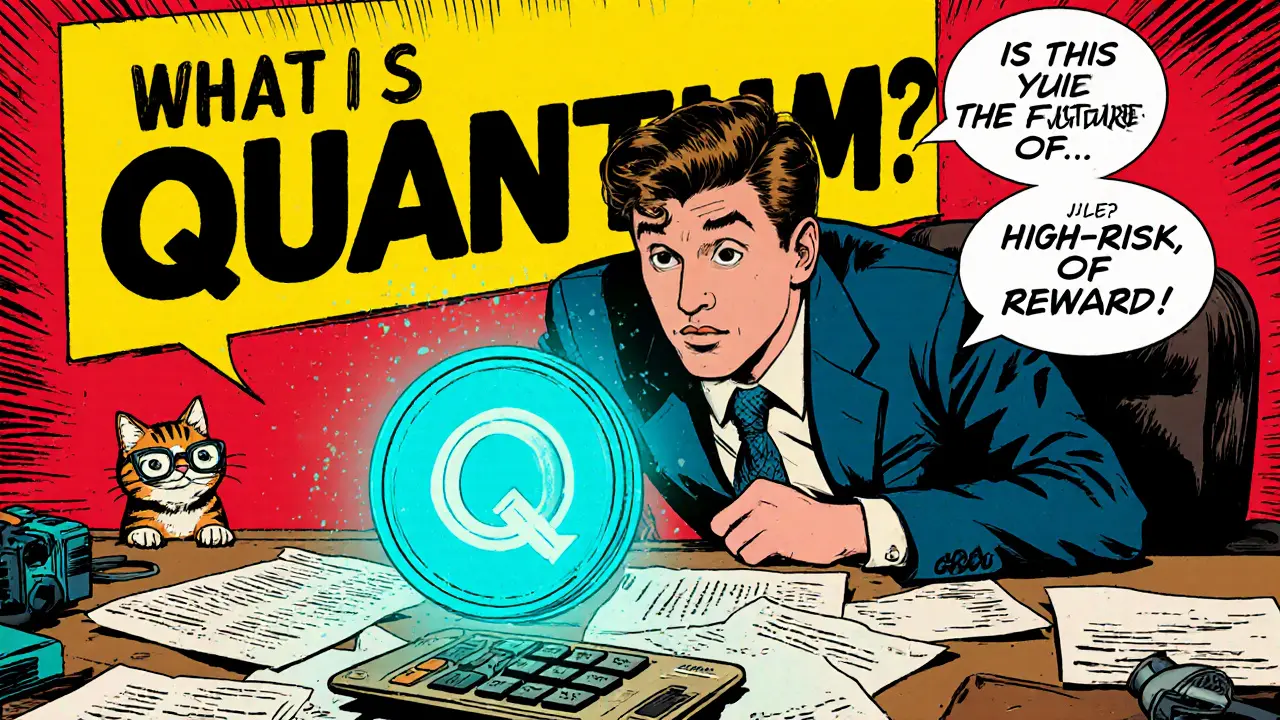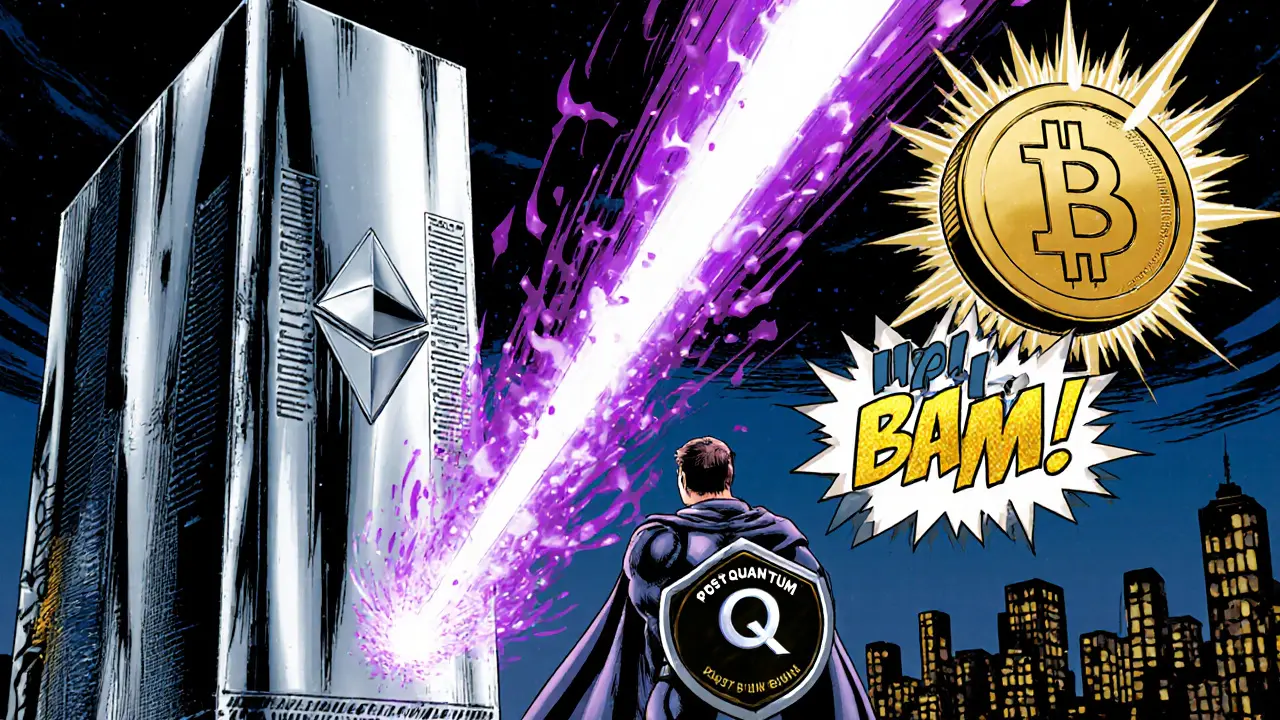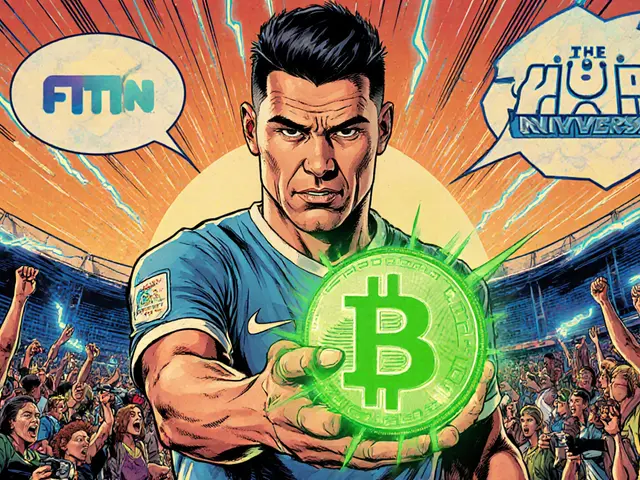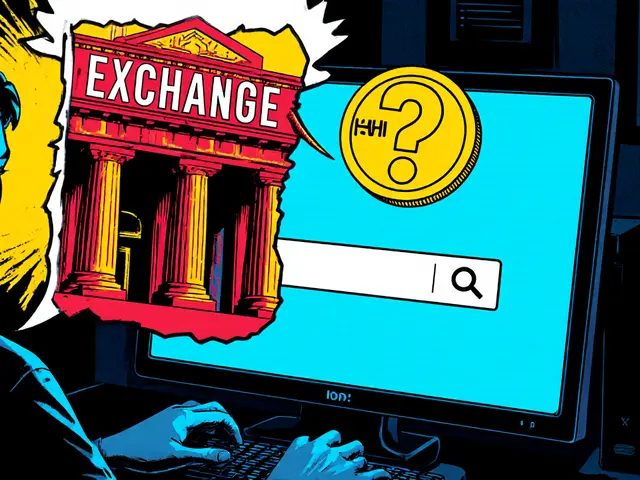
Quantum (Q) Coin Investment Calculator
Current Token Information
Symbol: Q
Current Price: $0.0315
Volatility: 42.9%
Market Cap: $15M
Investment Parameters
Investment Analysis
Enter your investment details and click "Calculate Potential Outcome" to see your projected results.
Current token price: $0.0315
Investment amount: $1000
Number of tokens purchased: 31,746
Projected value after change: $1000
Potential gain/loss: $0
Ever stumbled on a coin called Quantum (Q) and wondered what it actually is? You’re not alone. The name promises futuristic tech, but the reality is a mix of market speculation, price volatility, and a broader debate about quantum computing’s impact on all digital money.
What you need to know
- Quantum (Q) is a low‑priced utility token that trades under the symbol Q.
- Current price hovers around $0.0315 with high 42.9% volatility.
- There is limited public information about its team, roadmap, or tokenomics.
- The token’s name riffs on the growing concern that quantum computing could break today’s cryptographic safeguards.
- Investors should treat Q like any speculative altcoin - do deep‑dive research before committing funds.
What is Quantum (Q) token?
In simplest terms, Quantum (Q) is a cryptocurrency token that lives on a public blockchain (the specific chain isn’t consistently reported, but most listings place it on Binance Smart Chain). It carries the ticker Q and, as of 2Oct2025, trades at roughly $0.031476 per token.
Technical charts show a 50‑day Simple Moving Average of $0.0143 and a 200‑day SMA of $0.0063, meaning the price is well above its long‑term trend. The 14‑day Relative Strength Index sits at 66.9, hinting the coin may be edging toward overbought territory.
Because the project’s whitepaper, team bios, and detailed tokenomics are sparse, most analyses focus on price movement rather than intrinsic value. In practice, that makes Q a classic “high‑risk, high‑reward” asset.
How does the token work?
Without an official technical document, we can only piece together basics from exchange listings:
- It follows the ERC‑20 (or BEP‑20) token standard, meaning it inherits standard wallet compatibility and can be transferred with a simple transaction.
- Supply figures vary, but many sources list a total supply in the tens of billions, diluting individual token value.
- No staking, governance, or unique utility has been publicly confirmed, so the token currently functions mainly as a speculative vehicle.
If the project later adds features-like a DeFi bridge or a quantum‑resistant encryption layer-those details will likely appear in community channels or a future roadmap update.
Why does the name ‘Quantum’ matter?
The crypto world is buzzing about quantum computing because it threatens the cryptographic math that secures blockchains today. Most cryptocurrencies rely on RSA or Elliptic Curve Cryptography (ECC) to protect private keys. A sufficiently powerful quantum computer could solve the underlying mathematical problems in seconds, effectively stealing funds.
Industry experts point to a looming "Q‑Day"-the moment quantum machines become capable of breaking RSA‑2048 or ECC‑256. Google Quantum AI’s 2025 breakthrough, for example, reduced the time needed to solve RSA‑2048 from years to minutes. If that trajectory continues, the risk to assets like Bitcoin could become acute within a decade.
Because of this, many projects are exploring post‑quantum cryptography (PQC) solutions such as lattice‑based signatures, hash‑based schemes, and supersingular isogeny cryptography. The name “Quantum” in the token’s branding is likely a marketing nod to that broader conversation rather than a claim of built‑in quantum resistance.
Quantum‑resistance efforts in major blockchains
While Q itself may not yet incorporate PQC, the ecosystem is actively preparing:
- Bitcoin has seen several Bitcoin Improvement Proposals (BIPs) in 2025, notably the Quantum‑Resistant Address Migration Protocol (QRAMP). QRAMP outlines a gradual shift from ECDSA signatures to lattice‑based alternatives, allowing users to migrate safely.
- Ethereum plans the "Splurge" upgrade, which adds native support for PQC algorithms and enables account abstraction to swap out cryptographic primitives without hard forks.
- Industry reports estimate that about 25% of existing Bitcoin UTXOs are vulnerable to quantum attacks, reinforcing the urgency of these upgrades.
These initiatives demonstrate that the quantum threat is real, but they also show that the wider community is moving toward mitigation, which could influence investor sentiment around any coin that brands itself with the word “Quantum.”

Is Quantum (Q) truly quantum‑focused?
Given the lack of concrete technical details, it’s hard to say that Q offers any genuine quantum‑resistant features. The token appears to capitalize on the buzz:
- There’s no publicly audited cryptographic library tied to the token.
- Community forums rarely discuss PQC integrations; most chatter revolves around price speculation.
- The official website (if one exists) does not list a roadmap for quantum resistance.
In short, the “Quantum” label is more hype than hard tech at this stage. Investors should treat it as a brand name rather than a guarantee of future-proof security.
Investment outlook: price, volatility, and risk
Price analysts from platforms like CoinCodex predict a possible dip to $0.0237, a 25% drop from today’s level. Yet the sentiment index reads a neutral 49, and the token shows 57% green days over the last 30‑day window. Technical indicators suggest short‑term bullish momentum but also warn of overbought conditions.
Key risk factors:
- Information scarcity: No verifiable whitepaper or team data.
- Regulatory exposure: Small‑cap altcoins are often targeted by exchange delistings.
- Market volatility: 42.9% price swings can erase gains quickly.
- Quantum relevance: If the token never delivers on its implied promise, it could be perceived as a gimmick.
For a speculative trader, a short‑sell strategy-selling $1,000 worth now and buying back if the price falls to $0.0239 by year‑end-could theoretically net ~24% profit, according to model projections. However, transaction fees and slippage can erode that margin.
How to buy and store Quantum (Q) safely
- Find a reputable exchange that lists Q (e.g., KuCoin, Gate.io). Verify the token contract address on the exchange’s official page.
- Purchase the token using a stablecoin or fiat‑on‑ramp if available.
- Transfer Q to a non‑custodial wallet that supports the token’s standard (MetaMask for ERC‑20, Trust Wallet for BEP‑20).
- Enable any available security features: two‑factor authentication on the exchange, hardware wallet storage for private keys.
- Consider a cold‑storage solution for large holdings, especially if you plan to hold beyond a few weeks.
Remember, the security of your funds hinges on the strength of your private keys-not on the token’s name.
Quick comparison with major coins
| Crypto | Symbol | Current Price (USD) | Quantum‑Resistance Status | Key Initiative |
|---|---|---|---|---|
| Quantum (Q) | Q | 0.0315 | None (branding only) | N/A |
| Bitcoin | BTC | ~$68,200 | Planned via QRAMP (BIP) - not yet active | Quantum‑Resistant Address Migration Protocol |
| Ethereum | ETH | ~$2,850 | Roadmap includes PQC in Splurge upgrade (2025‑2026) | Splurge upgrade - native PQC support |
Bottom line
If you’re chasing a low‑price altcoin and don’t mind the unknown, Quantum (Q) can fit a high‑risk portfolio. But if you expect the token to shield you from future quantum attacks, the current reality falls short - it’s more a marketing label than a technical solution. Treat Q like any other speculative token: do your own research, keep exposure modest, and stay aware of the broader quantum‑computing saga that’s reshaping the crypto landscape.
Frequently Asked Questions
What blockchain does Quantum (Q) run on?
Most listings place Q on the Binance Smart Chain (BEP‑20) or as an ERC‑20 token on Ethereum. Always check the contract address on the exchange before buying.
Is Quantum (Q) actually quantum‑resistant?
No public audit or technical paper shows that Q uses post‑quantum cryptography. The name is currently a branding choice, not a security feature.
How volatile is the token?
The 30‑day volatility index sits at about 42.9%, meaning price swings of nearly half the token’s value are common.
What is QRAMP and how does it relate to Bitcoin?
QRAMP stands for Quantum‑Resistant Address Migration Protocol. It’s a Bitcoin Improvement Proposal that outlines a phased move from ECDSA signatures to lattice‑based signatures, aiming to protect future BTC holdings from quantum attacks.
Can I use a hardware wallet for Quantum (Q)?
Yes, if the hardware wallet supports the underlying token standard (ERC‑20 or BEP‑20). Devices like Ledger Nano S/X and Trezor Model T can store Q alongside other assets.






There are 21 Comments
Angela Yeager
Quantum (Q) certainly rides the hype wave, but the fundamentals look thin. The price volatility you highlighted at around 43% is a red flag for anyone looking for stability. If you’re thinking of adding it to a diversified portfolio, keep the allocation tiny and treat it as a speculative experiment. Always double‑check the contract address before you move any funds. And remember, the name doesn’t guarantee any quantum‑resistance technology.
vipin kumar
Everyone’s missing the big picture – the quantum threat isn’t a future meme, it’s already being weaponized in shadow labs. That’s why these low‑cap tokens like Q are bait for the unwary, pushing them into a data‑harvest funnel. The lack of a whitepaper is intentional, masking the true agenda. If the powers that be wanted to test post‑quantum cryptography, they’d release an open‑source protocol, not a vague token. Stay vigilant.
Lara Cocchetti
The conspiracy angle is entertaining, but the market data still shows Q is just another meme‑coin. Its volume is low, making manipulation easy.
Mark Briggs
Looks like another pump‑and‑dump.
mannu kumar rajpoot
Sure, but think about who profits when you buy at $0.03 and dump at $0.05 – the insiders. The token’s anonymity gives them cover, and the hype around quantum tech is just a smokescreen. You’d be wiser to keep your money in something with real utility.
Tilly Fluf
While the speculative nature of Q is evident, it does present an educational case for newcomers to understand token economics. The high volatility index can be leveraged for short‑term trading strategies, provided risk management is meticulous. Always store your Q in a non‑custodial wallet to retain control over private keys. And keep an eye on any roadmap updates that might introduce genuine utility. Wishing everyone prudent investing.
Darren R.
Indeed, the comparative table you posted is quite informative-however, the lack of quantum‑resistance is glaring; one must question whether the branding is merely a marketing ploy! Moreover, the token’s SMA values suggest a bullish overextension; caution is advised! Lastly, diversification remains the cornerstone of any resilient portfolio.
Hardik Kanzariya
Hey folks, if you decide to dip your toe in Q, start with a small amount you’re comfortable losing. Use a hardware wallet like Ledger if you plan to hold for more than a few weeks. And always double‑check the contract address on the exchange to avoid scam tokens. Happy trading!
Shanthan Jogavajjala
From a technical standpoint, Q adheres to the BEP‑20 standard, meaning integration with DeFi protocols is seamless-though the ecosystem support is minimal. Liquidity pools remain shallow, leading to slippage on larger orders. Consequently, any arbitrage opportunities are fleeting. Monitoring on‑chain metrics can reveal hidden patterns.
Jack Fans
For those interested in the price action, the 30‑day volatility metric of 42.9% indicates you could see swings of nearly half the token’s value in a week. That kind of movement is perfect for day traders who can manage tight stop‑losses. However, the low market cap also means a single whale can move the price dramatically. Always keep your exposure modest.
Adetoyese Oluyomi-Deji Olugunna
One must also consider the sociocultural capital attached to the moniker “Quantum” – it carries a veneer of sophistication that may attract less‑savvy investors.
Krithika Natarajan
Q’s price volatility is high. Treat it like any other high‑risk altcoin.
Rebecca Stowe
Staying optimistic is fine, but always set a clear exit strategy. If you’re in for the hype, decide beforehand at what price you’ll cash out. It helps protect you from the inevitable pull‑back.
Aditya Raj Gontia
Looks like another over‑hyped token with no real use case.
Kailey Shelton
Yeah, not much to say beyond the usual warnings.
Linda Welch
Let me break down why Quantum (Q) is a textbook example of modern crypto hype. First, the name itself is a clever marketing hook that banks on the public’s fear of quantum computers breaking encryption. Second, the token provides no verifiable quantum‑resistant technology, making the branding pure smoke. Third, its market cap of $15 million is minuscule, meaning a single large holder can dictate price movements. Fourth, the token’s supply runs into the tens of billions, diluting any inherent value. Fifth, the price’s 42.9 % volatility index is a red flag for anyone who isn’t a day‑trader. Sixth, there is a complete lack of a published roadmap, which should alarm any diligent investor. Seventh, community chatter is dominated by speculation rather than technical discussion. Eighth, the token’s listings on exchanges like KuCoin are often the only source of liquidity, adding an extra layer of risk. Ninth, transaction fees on the underlying chain can erode profits on small trades. Tenth, the token’s SMA indicators suggest it’s currently over‑bought, hinting at a potential correction. Eleventh, there are no staking or governance incentives to lock up the token, removing any reason to hold long‑term. Twelfth, the quantum‑resistance narrative is mostly a buzzword, not backed by any audited cryptographic work. Thirteenth, regulatory scrutiny on low‑cap tokens is intensifying, increasing delisting risk. Fourteenth, the token’s whitepaper is either missing or extremely sparse, offering no insight into tokenomics. Fifteenth, the community’s response to critical questions is often evasive, reinforcing the notion that the project is more about hype than substance. In summary, unless you are specifically looking for a high‑risk, high‑reward gamble, Q probably isn’t worth your capital.
Kevin Fellows
Got the TL;DR – sounds risky but could be fun for a tiny bet.
meredith farmer
Fun doesn’t pay the bills; keep your expectations realistic. The token’s volatility will eat away any small gains. Focus on assets with real utility.
Peter Johansson
Hey everyone 😊, just a reminder: diversify and don’t put all your crypto eggs in a single quantum‑themed basket. Even the most promising projects have bumps.
Vaishnavi Singh
Philosophically, the hype around quantum security reflects our deeper anxiety about the unknown future of technology. Yet, without concrete implementation, it remains a narrative rather than a solution.
Andrea Tan
Interesting read! I’d say keep an eye on the project but stay grounded in your risk tolerance.
Write a comment
Your email address will not be published. Required fields are marked *